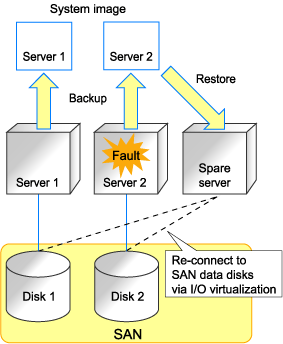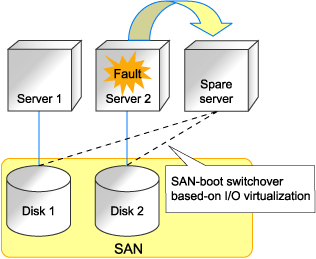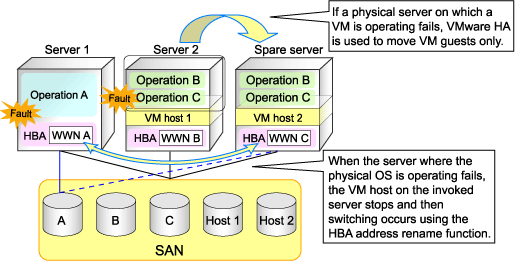This section provides examples of switchover configurations for each different switchover method.
Each method has its own restrictions regarding the supported hardware environment. Refer to the "Note" in "1.2 Hardware Environment" of the "ServerView Resource Coordinator VE Installation Guide" for details on the hardware environments supported by each switchover method.
Spare server configuration for local-boot servers
At least one spare server should be set aside for servers in local boot environments.
When a primary server fails, a system image (that must be backed up beforehand) will be restored to the spare server, and the spare server will be started up. Note that one or more spare servers can be shared by one or more primary servers.
If a local-boot server is using SAN storage for data storing purposes, this SAN storage space will also be accessible to the spare server.
Figure 9.1 Spare server configuration for local-boot servers

Spare server configuration for SAN-boot servers
At least one spare server should be set aside for servers in a SAN boot environment.
When a primary server fails, a WWN configured for an HBA is transferred to the spare server, which is then connected to a boot disk and started up. One or more spare server can be shared by multiple primary servers.
Figure 9.2 Spare server configuration for SAN-boot servers

For spare server configurations based on I/O virtualization, one or more spare servers can be shared by multiple physical OS's and VM guests (using the high-availability feature provided with their server virtualization software). For details on the server virtualization products supporting this configuration, refer to "A.1 Supported Functions".
In this case, spare servers should be set up as a VM hosts booting from a SAN, so that when a physical server hosting VM guests experiences a failure, the high-availability feature provided with their virtualization software can be used to transfer the VM guests to this spare VM host.
If a server running a physical OS fails, its boot disk will be reconnected to the spare server by means of an HBA address rename. When this happens, the spare server is halted, reconnected to the primary server's boot disk, and started up as the new active server.
Figure 9.3 Sharing a spare server between physical OS's and VM guests

Note
A spare server cannot be shared by a local boot server and a SAN boot server.